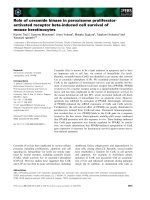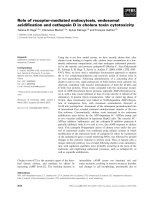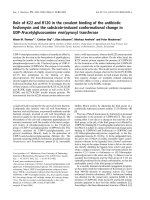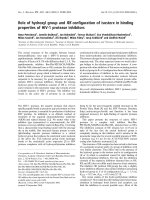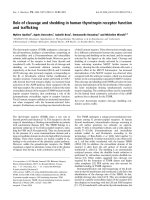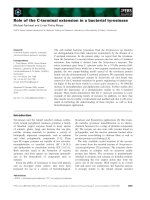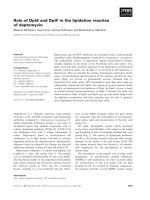Báo cáo khoa học: "Role of mucosal mast cells in visceral hypersensitivity in a rat model of irritable bowel syndrome" ppt
Bạn đang xem bản rút gọn của tài liệu. Xem và tải ngay bản đầy đủ của tài liệu tại đây (837.99 KB, 6 trang )
-2851$/ 2)
9H W H U L Q D U \
6FLHQFH
J. Vet. Sci.
(2004),
/
5
(4), 319–324
Role of mucosal mast cells in visceral hypersensitivity in a rat model of
irritable bowel syndrome
Jun-Ho La
1
, Tae-Wan Kim
2
, Tae-Sik Sung
1
, Hyun-Ju Kim
1
, Jeom-Yong Kim
3
, Il-Suk Yang
1,
*
1
Department of Physiology, College of Veterinary Medicine, Seoul National University, Seoul 151-742, Korea
2
Department of Physiology, College of Veterinary Medicine, Kyungpuk National University, Daegu 702-701, Korea
3
Institute of Bioscience and Biotechnology, Daewoong Pharm Co. LTD., Yongin 449-814, Korea
The involvement of mucosal mast cells (MMC) in the
pathophysiology of irritable bowel syndrome (IBS) is still
controversial. We aimed to re-evaluate the role of MMC in
visceral hypersensitivity associated with IBS using a rat
IBS model that develops the IBS symptom after a
subsidence of acetic acid-induced colitis. No significant
difference in the number of MMC was observed between
normal rat colon and IBS rat colon. (61.7
±
2.9/mm
2
in
normal vs. 88.7
±
13.3/mm
2
in IBS,
p
> 0.29). However, the
degranulation rate of MMC was significantly higher in
IBS rat colon (49.5
±
2.4% in normal vs. 68.8
±
3.4% in
IBS,
p
< 0.05). Pretreatment of a mast cell stabilizer,
doxantrazole (5 mg/kg, i.p.), reduced the degranulation
rate of MMC and significantly attenuated visceral
hypersensitivity to rectal distension in IBS rat, whereas it
had no effect on the visceral sensory responses in normal
rat. These results suggest that, although the number of
MMC is not significantly changed in IBS rat colon, the
higher degranulation rate of MMC is responsible for
visceral hypersensitivity in this model IBS.
Key words:
Irritable bowel syndrome, visceral hypersensitiv-
ity, mucosal mast cell.
Introduction
Irritable bowel syndrome (IBS), a chronic disorder in the
absence of objective abnormalities in structures, is the most
common disorder encountered by gastroenterologist [6].
Investigators have demonstrated that one of the important
pathophysiological features of IBS is a lowered threshold for
visceral pain elicited by luminal mechanical and chemical
stimuli, a phenomenon referred to as visceral hypersensitivity
[19,26]. However, the etiology and the pathophysiological
mechanism of IBS remain poorly understood.
Recently, researchers have suggested the role of
inflammatory cells in the pathogenesis of IBS [2]. Patients
with ulcerative colitis in remission often express IBS-like
symptoms [16], and IBS patients have a low but significant
increase in immune cells in colonic mucosa and in jejunal
myenteric plexus [14,27]. Among the inflammatory cells,
mucosal mast cells (MMC) have gained researcher’s interest
in relation to IBS. MMC locates throughout the gut in close
proximity to enteric nerves [24], and secretes numerous
inflammatory substances including histamine, cytokines,
proteases, and eicosanoids [4] that are known to sensitize
visceral sensory nerve fibers [12].
Despite these findings, it is still controversial whether
MMC plays a key role in IBS. Several investigators have
noted an increased number of MMC in terminal ileum [28]
and in caecum of IBS patients [21], but others found neither
changes in the number of MMC in IBS patients [15,23,25]
nor correlation between the number of MMC and the extent
of IBS symptoms [7]. Thus, we aimed to re-evaluate the
pathophysiological role of MMC in IBS using an animal
model of IBS. In our previous study, we reported that rats
develop IBS symptoms after subsidence of acetic acid-
induced colitis, showing visceral hypersensitivity to rectal
distension [17]. In the present study, we focused to
investigate (1) whether the number of MMC in colon is
changed in this rat IBS model, and (2) whether the IBS
symptom (visceral hypersensitivity) can be alleviated by the
inhibition of mast cell degranulation.
Materials and Methods
Experimental animals and induction of IBS
Male Sprague-Dawley rats (270~310 g) were housed in
stainless steel hanging cages in colony room maintained
under a 12 h light/dark cycle with a room temperature of
22 ± 1
o
C and humidity of 65-70%. Water and food were
available
ad libitum
. IBS symptoms were produced as
described previously [17]. Briefly, colitis was induced by
intracolonic instillation of 1 ml 4% acetic acid. Control
*Corresponding author
Tel: +82-2-880-1261; Fax: +82-2-885-2732
E-mail:
320 Jun-Ho La
et al.
animals received saline instead of acetic acid. Rats were left
to recover from colitis for 6 days, and used for experiments
at 7 days after induction of colitis.
Mucosal mast cells counting
On the day of experiments, rats were sacrificed by
cervical dislocation and the distal colon was dissected. The
colonic samples were fixed in Carnoy’s fixative for 2 hr at
room temperature, and then transferred to 30% sucrose in
phosphate buffered solution at 4
o
C overnight. Sample blocks
embedded in OCT compound (Sakura Finetechnical Co.,
Japan) were cut into 10
µ
m thick transverse sections in a
cryostat-microtome. The sections were reacted with 0.5%
toluidine blue in 0.5 N HCl for 30 min. Specimen was
examined under a light-microscope (Axioskop, Carl Zeiss,
Germany) and digitally photographed at
×
400 (Micromax
cooled-CCD, Princeton Instrument, USA). Three sections
per animal were examined and the number of MMC was
counted in at least 10 randomly selected fields using an
image analyzing software. Loss of intracellular granules,
with stained material dispersed diffusely within the lamina
propria, was taken as an evidence of MMC degranulation
[5]. The number of MMC was expressed as mean number of
cells per mm
2
, and the degranulation rate of MMC was
expressed as a percentile proportion of the degranulated
MMC to the total MMC in the photographed fields.
Visceral sensory responses to rectal distension
Overnight fasted rats were lightly anesthetized with either,
and disposable silicon balloon-urethral catheter for pediatric
use (6 Fr, Sewoon Medical, Korea) was inserted intra-anally
until the end of the balloon was 2 cm inside the rectum. Rats
were placed in a transparent cubicle (20
×
8
×
8 cm) on a
mirror-based elevated platform and were allowed to recover
and acclimate for a minimum of 30 min before testing. After
animals were fully awaken and acclimate, ascending-limits
phasic distension (0.1, 0.2, 0.3, 0.4, 0.6, 0.8 and 1 ml) with
pre-warmed (37
o
C) water was applied for 30 sec every 4
min. The visceral sensory responses to rectal distension was
quantified by scoring the abdominal withdrawal reflex
(AWR), as described previously [17], and simultaneously
measuring the concomitant increase in arterial pulse rate
(tachycardia) from caudal artery using a non-invasive pulse
transducer (MLT125R, AD Instruments, Australia). The
AWR score and the pseudo-affective tachycardiac responses
are reported to be the reliable indicators of the visceral
sensory response to luminal distension [1,17,20].
The overall difference in the visceral sensory responses
between groups was determined by taking the area under the
curve (AUC) that was calculated as the sum of responses
plotted against the distension volume using the trapezoidal
rule.
Effect of a mast cell stabilizer
The effect of doxantrazole ((3-(1
H
-tetrazol-5-yl)-9
H
-
thioxanthen-9-one 10,10-dioxide monohydrate, Aldrich,
Milwaukee, WI, USA), a mast cell stabilizer, was investigated
in normal and IBS rats. Doxantrazole (5 mg/kg, i.p.) was
dissolved in dimethylsulfoxide (DMSO) and injected
30 min before experimentation. Control animals received an
equal amount of DMSO as a vehicle.
Statistical analyses
Data were expressed as mean
±
SEM, with n, the number
of animals. The difference in the values was statistically
analyzed using Mann-Whitney U (MWU)-test at the
p
<0.05
significance level. Comparisons between three or more
groups were performed with Kruskal-Wallis test (KW test)
followed by nonparametric Dunn’s test.
Results
The number of MMC in distal colon
In the toluidine blue-stained colonic specimens, MMC
was easily identified in the lamina propria. The mean
number of MMC was 61.7
±
2.9/mm
2
(n = 5) in normal rat
colon and 88.7
±
13.3/mm
2
(n = 5) in IBS rat colon (Fig. 1).
There was no statistically significant difference between
these values (
p
> 0.29).
The degranulation rate of MMC in distal colon
The degranulation rate of MMC was significantly higher
in IBS rat colon than in normal colon. In IBS rat colon,
F
ig. 1.
The number of mucosal mast cells (MMC) in colon
ic
m
ucosa. MMC was stained by 0.5% acidic toluidine blue. B
ar
i
ndicates 100 µm in the upper left photograph. No statistical
ly
s
ignificant difference was detected between normal and IB
S
g
roup (P = 0.29 by MWU test, n = 5 in each group).
Role of mucosal mast cells in IBS rat 321
68.8
±
3.4% MMC (n = 5) was identified to be degranulated,
whereas in normal colon, 49.5
±
2.4% MMC (n = 5) was
degranulated (
p
< 0.05) (Fig. 2). In the groups that received
a mast cell stabilizer, doxantrazole (5 mg/kg, i.p.), the
degranulation rate of MMC was reduced to 31.3
±
2.4%
(n = 5) in normal rat colon (
p
< 0.05 vs. normal control) and
to 32.2
±
3.9% (n = 5) in IBS rat colon (
p
< 0.05 vs. IBS
control). The degranulation rate of MMC in the doxantrazole-
treated groups was not different between normal and IBS rat
colon (
p
>0.8).
Effect of a mast cell stabilizer on the responses to rectal
distension
Upon phasic rectal distension, rats showed the characteristic
AWR behavior and the tachycardiac pseudo-affective
response. These visceral sensory responses increased as the
intensity of distending stimulus was raised. As shown in Fig.
3, the visceral sensory responses to rectal distension were
exaggerated in the IBS rat, resulting in the significant
increase in the AUC of the stimulus-response plots (1.7
±
0.2 vs. 2.5
±
0.1 in the AWR score,
p
< 0.01; 38.5
±
1.9 vs.
57.2
±
7.7 in the
∆
pulse rate, P = 0.03, n = 7 in both
groups). These results indicate that the IBS rat has visceral
hypersensitivity. We examined whether the visceral
hypersensitivity in the IBS rat is related to degranulation of
MMC. In normal rats, doxantrazole had no effect on either
the visceral sensory AWR behavior or the pseudo-affective
tachycardiac responses to rectal distension (Fig. 4).
However, the same dose of mast cell stabilizer effectively
alleviated the visceral hypersensitivity in IBS rats. By the
pretreatment of doxantrazole, the AUC of the stimulus-
response plots was significantly reduced from 2.5
±
0.1 to
1.9
±
0.2 (P = 0.022) in the AWR score and from 57.2
±
7.7
to 29.5
±
4.6 (
p
<0.01) in the
∆
pulse rate (Fig. 5).
Discussion
This study demonstrates that the number of MMC is not
changed in IBS rat (Fig. 1). Because the rat model of IBS
used in this study develops IBS symptom after subsidence of
colonic inflammation, our observation could reflect the
condition of post-infectious IBS (PI-IBS) patients who
acquire the IBS symptoms after an episode of intestinal
infection and inflammation. Thus, it can be supposed that
patients with PI-IBS may not show notable changes in the
number of MMC in colonic mucosa. Indeed, it was recently
reported that the number of MMC in PI-IBS patients is
virtually identical to that in healthy subjects [11,23].
Although no change was observed in the number of MMC
in IBS rat, this result does not necessarily mean that MMC
does not play a role in the pathophysiology of IBS. We
found that the percentage of degranulated MMC is
significantly higher in IBS rat colon than in normal colon
(Fig. 2). This finding implies that the state of MMC
degranulation, rather than the total number of MMC, may be
related to the IBS symptom development. Supporting this
notion, we observed that the inhibition of MMC
degranulation by doxantrazole could effectively attenuate
F
ig. 2.
The degranulation rate of MMC in colonic mucos
a.
D
oxantrazole (5 mg/kg, i.p.) was administered 30 min prior
to
t
he sacrifice. Control animals received DMSO as a vehic
le.
*
p
<0.05 vs. normal,
#
p
<0.05 vs. corresponding control group
by
K
W test followed by Dunn’s test (n=5 in each group).
F
ig. 3.
Visceral sensory responses to phasic rectal distension. (A
)
S
core of the AWR behavior and (B) the extent of tachycardi
ac
p
seudo-affective response upon rectal distension. Inset pl
ot
r
epresents the area under the curve (AUC). *
p
<0.05, **
p
<0.
01
v
s. normal (n=7 in each group).
322 Jun-Ho La
et al.
visceral hypersensitivity to rectal distension in the IBS rat.
Doxantrazole significantly inhibited the AWR behavior and
the tachycardiac pseudo-affective responses to rectal
distension (Fig. 5). Recent studies further support the
importance of MMC degranulation in the IBS symptoms.
The degranulation rate of MMC in close proximity to nerves
is reported to be significantly higher than that of MMC away
from nerves in the colorectal specimens of diarrhea-
predominant IBS patients [22], and a significant correlation
is found between vicinity of MMC to nerves and the severity
of abdominal pain/discomfort symptom of IBS [3]. These
findings, together with our current observation, suggest that
the degranulation of MMC is an important pathophysiological
factor in visceral hypersensitivity associated with IBS. In
experimental animals, the role of MMC degranulation in
visceral hypersensitivity has been demonstrated; doxantrazole
significantly inhibited the exaggerated depressor response to
jejunal distension in rats at 30 days post-nematode infection
[18] and the increased abdominal response to rectal
distension in stressed rats [13].
It is interesting that about a half of MMC is in the
degranulated state in normal rat colon, and this degranulation
rate is reduced to 31.3
±
2.4% by the pretreatment of
doxantrazole (Fig. 2). In keeping with our conclusion that
degranulation of MMC causes the exaggeration of the
visceral sensory responses to rectal distension, it is quite
expectable that, in normal rat, doxantrazole can also reduce
the visceral sensory behavior and the pseudo-affective
response to some extent. However, we did not find any
significant effect of doxantrazole on the visceral sensory
responses to rectal distension in normal rats. Considering
that the activation rate of MMC away from nerves was
similar between IBS patients and control subjects [22], it
could be assumed that such MMC degranulation rate as in
normal rat colon represents the activation state of MMC
away from nerves, and hence cannot produce any significant
change in visceral sensory function. A further ultrastructural
study is required to provide evidences for this assumption.
It is well known that mast cells can synthesize a variety of
substances, and these substances can sensitize sensory
neuron [4]. Although it is beyond the scope of the present
study to identify the most important mast cell mediators that
are responsible for visceral hypersensitivity in IBS, it is
worthy to mention that antagonists of H
1
, H
2
, and H
3
histamine receptors did not modify but 5-HT
1A
receptor
antagonist effectively reduced the mast cell activator-
induced visceral allodynia [8]. In addition, it was also
reported that experimental activation of proteinase-activated
F
ig. 4.
Effect of doxantrazole on the visceral sensory respons
es
i
n normal rats.
Doxantrazole (DOX, 5 mg/kg, i.p.), administer
ed
3
0 min before the rectal distension, had no effect on either (A
)
t
he AWR score or (B) the extent of tachycardiac response
in
n
ormal rats (n=7 in each group).
F
ig. 5.
Effect of doxantrazole on the visceral hypersensitivity
in
I
BS rats.
Pretreatment of doxantrazole (DOX, 5 mg/kg, i.p
.)
a
ttenuated both (A) the AWR score and (B) the extent
of
t
achycardiac response in IBS rats. *
p
<0.05, **
p
<0.01 vs. contr
ol
b
y MWU test (n=7 in each group).
Role of mucosal mast cells in IBS rat 323
receptor-2 (PAR-2), which could be activated endogenously
by mast cell tryptase [10], induced visceral hyperalgesia in
rats [9]. It would be of interest in future study to examine
whether serotonin acting on 5-HT
1A
receptor and tryptase
acting on PAR-2 are involved in visceral hypersensitivity in
IBS rats.
In conclusion, we found that the number of MMC in colon
is not changed, but the degranulation rate of MMC is higher
in IBS rats. Additionally, we observed that the inhibition of
the MMC degranulation could attenuate visceral hypersensitivity
in IBS rats. These results suggest that the increased
degranulation of MMC might be responsible for the visceral
pain/discomfort symptom of IBS.
Acknowledgments
This work was supported by the Research Institute of
Veterinary Science (RIVS), Seoul National University, 2003.
References
1. Al-Chaer ED, Kawasaki M, Pasricha PJ. A new model of
chronic visceral hypersensitivity in adult rats induced by
colon irritation during postnatal development. Gastroenterology
2000, 119, 1276-1285.
2. Barbara G, De Giorgio R, Stanghellini V, Cremon C,
Corinaldesi R. A role for inflammation in irritable bowel
syndrome? Gut 2002, 51, i41-i44.
3. Barbara G, Stanghellini V, De Giorgio R, Cremon C,
Cottrell GS, Santini D, Pasquinelli G, Morselli-Labate
AM, Grady EF, Bunnett NW, Collins SM, Corinaldesi R.
Activated mast cells in proximity to colonic nerves correlate
with abdominal pain in irritable bowel syndrome.
Gastroenterology 2004, 126, 693-702.
4. Bauer OandRazin E. Mast Cell-Nerve Interactions. News
Physiol Sci 2000, 15, 213-218.
5. Boros M, Szalay L, Kaszaki J. Endothelin-1 induces
mucosal mast cell degranulation and tissue injury via ETA
receptors. Clin Sci (Lond) 2002, 103, 31S-34S.
6. Camilleri M. Management of the irritable bowel syndrome.
Gastroenterology 2001, 120, 652-668.
7. Celik AF, Demirkesen C, Pamuk ON, Pamuk GE,
Uzunismail H. Mast cells: do they really have a role in
disturbed bowel habits of IBS patients? Am J Gastroenterol
2001, 96, 927-929.
8. Coelho AM, Fioramonti J, Bueno L. Mast cell
degranulation induces delayed rectal allodynia in rats: role of
histamine and 5-HT. Dig Dis Sci 1998, 43, 727-737.
9. Coelho AM, Vergnolle N, Guiard B, Fioramonti J, Bueno
L. Proteinases and proteinase-activated receptor 2: a possible
role to promote visceral hyperalgesia in rats. Gastroenterology
2002, 122, 1035-1047.
10. Corvera CU, Dery O, McConalogue K, Bohm SK, Khitin
LM, Caughey GH, Payan DG, Bunnett NW. Mast cell
tryptase regulates rat colonic myocytes through proteinase-
activated receptor 2. J Clin Invest 1997, 100, 1383-1393.
11. Dunlop SP, Jenkins D, Spiller RC. Distinctive clinical,
psychological, and histological features of postinfective
irritable bowel syndrome. Am J Gastroenterol 2003, 98,
1578-1583.
12. Gebhart GF. Pathobiology of visceral pain: molecular
mechanisms and therapeutic implications IV. Visceral
afferent contributions to the pathobiology of visceral pain.
Am J Physiol Gastrointest Liver Physiol 2000, 278, G834-
G838.
13. Gue M, Del Rio-Lacheze C, Eutamene H, Theodorou V,
Fioramonti J, Bueno L. Stress-induced visceral
hypersensitivity to rectal distension in rats: role of CRF and
mast cells. Neurogastroenterol Motil 1997, 9, 271-279.
14. Gwee KA, Leong YL, Graham C, McKendrick MW,
Collins SM, Walters SJ, Underwood JE, Read NW. The
role of psychological and biological factors in postinfective
gut dysfunction. Gut 1999, 44, 400-406.
15. Irvine EJ, Gaebel K, Driman D, Riddel RH, Collins SM.
Mucosal mast cells (MMC) numbers are normal in biopsies
of patients with irritable bowel syndrome (IBS). 1995, 108,
A860 (Abstract).
16. Isgar B, Harman M, Kaye MD, Whorwell PJ. Symptoms
of irritable bowel syndrome in ulcerative colitis in remission.
Gut 1983, 24, 190-192.
17. La JH, Kim TW, Sung TS, Kang JW, Kim HJ, Yang IS.
Visceral hypersensitivity and altered colonic motility after
subsidence of inflammation in a rat model of colitis. World J
Gastroenterol 2003, 9, 2791-2795.
18. McLean PG, Picard C, Garcia-Villar R, Ducos de LaR,
More J, Fioramonti J, Bueno L. Role of kinin B1 and B2
receptors and mast cells in post intestinal infection-induced
hypersensitivity to distension. Neurogastroenterol Motil
1998, 10, 499-508.
19. Mertz H, Naliboff B, Munakata J, Niazi N, Mayer EA.
Altered rectal perception is a biological marker of patients
with irritable bowel syndrome. Gastroenterology 1995, 109,
40-52.
20. Ness TJandGebhart GF. Colorectal distension as a noxious
visceral stimulus: physiologic and pharmacologic characterization
of pseudaffective reflexes in the rat. Brain Res 1988, 450,
153-169.
21. O'Sullivan M, Clayton N, Breslin NP, Harman I, Bountra
C, McLaren A, O'Morain CA. Increased mast cells in the
irritable bowel syndrome. Neurogastroenterol Motil 2000,
12, 449-457.
22. Park CH, Joo YE, Choi SK, Rew JS, Kim SJ, Lee
MC.Activated mast cells infiltrate in close proximity to
enteric nerves in diarrhea-predominant irritable bowel
syndrome. J Korean Med Sci 2003, 18, 204-210.
23. Spiller RC, Jenkins D, Thornley JP, Hebden JM, Wright
T, Skinner M, Neal KR. Increased rectal mucosal
enteroendocrine cells, T lymphocytes, and increased gut
permeability following acute Campylobacter enteritis and in
post-dysenteric irritable bowel syndrome. Gut 2000, 47, 804-
811.
24. Stead RH, Tomioka M, Quinonez G, Simon GT, Felten
SY, Bienenstock J. Intestinal mucosal mast cells in normal
and nematode-infected rat intestines are in intimate contact
with peptidergic nerves. Proc Natl Acad Sci USA 1987, 84,
324 Jun-Ho La
et al.
2975-2979.
25.
Talley NJandButterfield JH.
Mast cell infiltration and
degranulation in colonic mucosa in the irritable bowel
syndrome. Am J Gastroenterol 1996,
91
, 1675-1676.
26.
Thompson WG, Longstreth GF, Drossman DA, Heaton
KW, Irvine EJ, Muller-Lissner SA.
Functional bowel
disorders and functional abdominal pain. Gut 1999,
45
(Suppl)
2
, II43-47.
27.
Tornblom H, Lindberg G, Nyberg B, Veress B.
Full-
thickness biopsy of the jejunum reveals inflammation and
enteric neuropathy in irritable bowel syndrome.
Gastroenterology 2002,
123
, 1972-1979.
28.
Weston AP, Biddle WL, Bhatia PS, Miner PB Jr.
Terminal
ileal mucosal mast cells in irritable bowel syndrome. Dig Dis
Sci 1993,
38
, 1590-1595.


